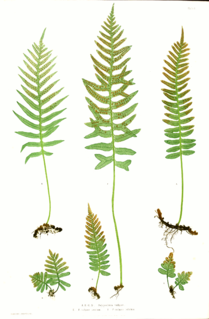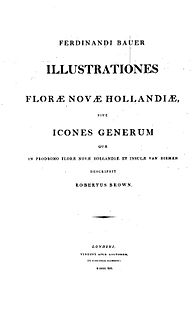 W
WBotanical illustration is the art of depicting the form, color, and details of plant species, frequently in watercolor paintings. They must be scientifically accurate but often also have an artistic component and may be printed with a botanical description in books, magazines, and other media or sold as a work of art. Often composed by a botanical illustrator in consultation with a scientific author, their creation requires an understanding of plant morphology and access to specimens and references.
 W
WBotanical illustration is the art of depicting the form, color, and details of plant species, frequently in watercolor paintings. They must be scientifically accurate but often also have an artistic component and may be printed with a botanical description in books, magazines, and other media or sold as a work of art. Often composed by a botanical illustrator in consultation with a scientific author, their creation requires an understanding of plant morphology and access to specimens and references.
 W
WThe Botanical garden of Thutmose III is a found in the temple of Amun Re, and was constructed during the Middle Kingdom by Thutmose III. This structure is unique from other architecture found during this time. This complex was composed of three rooms including an two antechambers that lead to the largest sanctuary of the complex. This large sanctuary is what is actually considered the Botanical Garden. The antechamber directly leading up to the Botanical garden can only be accessed through one calcite door that is high up off the ground and can only be reached and seen while using the staircase that leads up to it. However, this staircase was thought to commonly hold a tabernacle, so this door was not usually accessible. This antechamber is also notable for being uncommonly wide, which lead to the room requiring four pillars to hold up the ceiling. Between the outer two pillars there were sculptures of sphinxes that were positioned facing North towards the sanctuary, which was uncommon as well. There were many intricate carvings and designs on the walls that converge to the large door that leads to the Botanical Garden. Many of these depictions of scenes of the King and Gods doing different rituals, or celebrations. In the actual sanctuary, there were eight nooks carved into the wall, where divine statues were places. One of these was a granite statue of Thutmose III. On the walls of the sanctuary there were beautiful and detailed carvings of different plants and animals. Thutmose III expanded the boundaries of Egypt in the north and the south, collected a considerable collection of rare species of animals and lush plants. Those animals and botanical collections are found engraved on the walls of the sanctuary. Through the royal artists, the pharaoh boasts of the scenic beauty.
 W
WBritish Phaenogamous Botany is figures and descriptions of British flowering plants compiled by the botanist William Baxter.
 W
WCheekwood is a 55-acre (22 ha) historic estate on the western edge of Nashville, Tennessee that houses the Cheekwood Estate & Gardens. Formerly the residence of Nashville's Cheek family, the 30,000-square-foot (2,800 m2) Georgian-style mansion was opened as a botanical garden and art museum in 1960.
 W
WConstellation is a series of outdoor 2000 bronze sculptures by American artist Tad Savinar, installed at Holladay Park in northeast Portland, Oregon, United States. The work's three "distinct elements" include:Constellation or Constellation: Flowers from a Neighborhood Garden, a slender vase of daisies, hydrangeas and other flowers; Constellation (Molecule) or Constellation: Isolated Molecule for a Good Neighborhood, an abstract molecule representing a "good neighborhood"; and Constellation: Neighborhood Gardiner or simply Constellation, a female figure carrying gardening shears.
 W
WEnglish Botany was a major publication of British plants comprising a 36 volume set, issued in 267 monthly parts over 23 years from 1790 to 1814. The work was conceived, illustrated, edited and published by the botanical illustrator and natural historian, James Sowerby. The brief formal technical descriptions were mostly supplied by the founder of the Linnean Society, Sir James Edward Smith. Initially Smith had declined to have his name associated with the work as he considered that his professional co-operation with a socially inferior artisan such as Sowerby might degrade his standing in higher circles. However, following the phenomenal public success and general acceptance by the professional class of the work he insisted that the title page of the fourth and succeeding volumes credited the work to his name with Sowerby named solely as the illustrator. The work, however, continued to be generally referred to as "Sowerby's Botany". In spite of this abuse of their social class differences by Smith, the two men were good friends and happily worked together on several projects over many years. The work was printed by J. Davis, London; initially on Edmeads and Pine laid paper.
 W
WThe Ferns of Great Britain and Ireland was a book published in 1855 that featured 51 plates of nature printing by Henry Bradbury.
 W
WFlora Graeca is a publication of the plants of Greece in the late 18th century, resulting from a survey by John Sibthorp and Ferdinand Bauer. The botanical descriptions and illustrations became highly valued by the English audience; the finely crafted and illustrated work was of both scientific and horticultural interest.
 W
WFlora Londinensis is a folio sized book that described the flora found in the London region of the mid 18th century. The Flora was published by William Curtis in six large volumes. The descriptions of the plants included hand-coloured copperplate plates by botanical artists such as James Sowerby, Sydenham Edwards and William Kilburn.
 W
WIllustrationes florae Novae Hollandiae is an 1813 publication by the botanical illustrator Ferdinand Bauer.
 W
WMargaret Mee and the Moonflower is a 2012 Brazilian documentary film directed by Malu De Martino, about the work and legacy of British botanical artist Margaret Mee, who moved to Brazil in the 1950s, produced over 400 illustrations about Brazilian flora and, used her art as a tool to defend the environmentalism.
 W
WBessie Niemeyer Marshall was an American botanical illustrator known for her watercolor paintings of the wildflowers of Lee Memorial Park. Her artwork documented the variety of plant species being preserved in Lee Memorial Park, a Works Progress Administration-funded wildflower and bird sanctuary in Petersburg, Virginia.
 W
WNature printing is a printing process, developed in the 18th century, that uses the plants, animals, rocks and other natural subjects to produce an image. The subject undergoes several stages to give a direct impression onto materials such as lead, gum, and photographic plates, which are then used in the printing process.
 W
WNepenthes is a series of four sculptures by artist Dan Corson, installed in 2013 along Northwest Davis Street in the Old Town Chinatown neighborhood of Portland, Oregon, in the United States. The work was inspired by the genus of carnivorous plants of the same name, known as tropical pitcher plants. The sculptures are 17 feet (5.2 m) tall and glow in the dark due to photovoltaics.
 W
WThe U.S. Department of Agriculture's Pomological Watercolor Collection is an archive of some 7,500 botanical watercolors created for the USDA between the years 1886 and 1942 by around five dozen artists. Housed by the United States National Agricultural Library, it is a unique resource documenting existing fruit and nut cultivars, new introductions, and specimens discovered by USDA's plant explorers, representing 38 plant families in all. It has been called "one of the world's most unusual holdings of late 19th and early 20th century American botanical illustrations".
 W
WThe Cactaceae is a monograph on plants of the cactus family written by the American botanists Nathaniel Lord Britton and Joseph Nelson Rose and published in multiple volumes between 1919 and 1923. It was landmark study that extensively reorganized cactus taxonomy and is still considered a cornerstone of the field. It was illustrated with drawings and color plates principally by the British botanical artist Mary Emily Eaton as well as with black-and-white photographs.
 W
WThe William Farquhar Collection of Natural History Drawings consists of 477 watercolour botanical drawings of plants and animals of Malacca and Singapore by unknown Chinese artists that were commissioned between 1819 and 1823 by William Farquhar. The paintings were meant to be of scientific value with very detailed drawings, except for those of the birds which have text going beyond their original purpose. For each drawing, the scientific and/or common name of the specimen in Malay, and, occasionally, in English, was written in pencil. A translator also penned the Malay names in Jawi using ink. The paper used was normally European paper framed by a blue frame while some have no frames at all suggesting there are two artist.